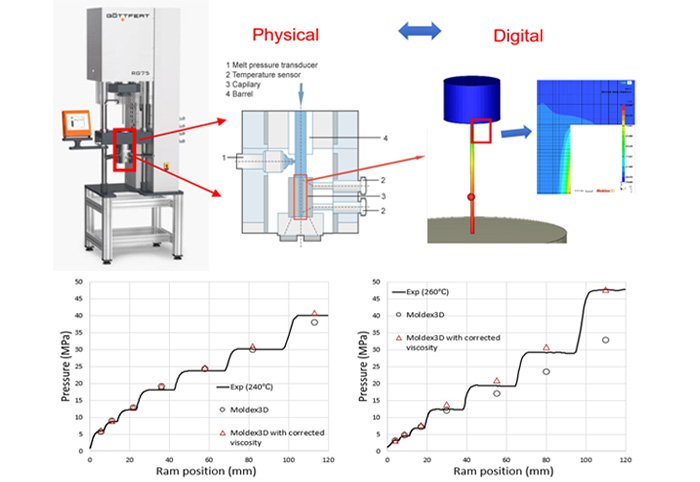
Digital Twin of Instrument Design and Material Measurement - Part 2
ESPECIALLY FOR OUR USERSThe accurate characterization of the different material properties of plastics, such as viscosity, pvT behavior and mechanical parameters for the process simulation of the injection molding process, represents a considerable challenge. To optimize the determination of material parameters, a digital twin can be implemented for both the development of measuring devices and the measurement method of plastic properties. In part 1 of our article, we reported about the "Digital Twin of the Measuring Instrument". Today we take an in-depth look into the "Digital Twin of a Material Measurement" ...
Usually, when determining viscosity by means of a capillary rheometer, it is assumed that a uniform temperature distribution prevails everywhere in the system under consideration. However, this assumption can no longer be made in the case of higher shear rates and the resulting temperature increase, both in the radial and axial direction in the capillary, as well as the viscosity change caused by this. In the case of amorphous thermoplastics in particular, a temperature change of 20 °C already causes a viscosity change in the range of 40 % to 150 %, depending on the shear rate acting. It is thus evident that neglecting the temperature increase when measuring viscosity is not permissible and leads to measurement errors. Although viscosity can be measured at a very high shear rate using a capillary rheometer or an online rheometer on the injection molding machine, the reliability of the data decreases sharply with increasing shear rate due to the influence of viscous heating.
The recording of the temperature distribution during the measurement with a capillary rheometer represents a metrological challenge due to the small capillary diameters (about 0.5 2 mm). Additionally, the temperature measurement would have to be recorded not only point by point but also in both radial and axial directions. The use of a digital twin of the material measurement can provide a remedy. The digital twin of the material measurement makes it possible to determine the distribution of physical quantities at any point in the system. Thus, the variations in the properties can be used to correct the data and parameters of the model via an iterative algorithm to improve the predictive accuracy and reliability of the process simulation.
For example, if the measured viscosity curves are fed into the simulation without making adjustments, the pressure prediction matches the measured data very well at low shear rates. At high shear rates, however, the pressure prediction is significantly underestimated due to shear heating and the resulting lower viscosity. After incorporating the correction determined by means of digital material twinning, the pressure predictions agree much better with the measurement even at high shear rates.
The digital material twin can be used to evaluate the change of material properties such as viscosity, pvT behavior, specific heat capacity, thermal conductivity, etc., as well as the evaluation of state changes such as pressure, thermal stress and temperature distribution, during the material measurement process. Furthermore, the complete digital twin model with the consideration of the individual components of the measuring device and the measurement process can be used not only to correct and improve the measurement data, but also as a powerful tool for material development and measurement, as well as for the development of measuring instruments.
